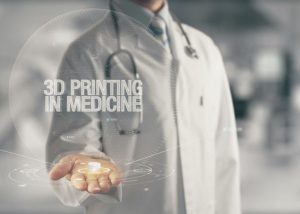 Three-dimensional (3D) printing is revealing its potential in the pharmaceutical industry as it turns personalised medicine into reality. In fact, additive manufacturing has the unique ability to deliver quickly, flexibly and economically set amounts of patient-specific drugs with bespoke properties, such as formulations, dosages or geometries. To achieve that and meet strict regulatory requirements, the pharmaceutical industry needs to set-up solid Quality by Design (QbD) strategies and process analytical technologies (PAT).
Three-dimensional (3D) printing is revealing its potential in the pharmaceutical industry as it turns personalised medicine into reality. In fact, additive manufacturing has the unique ability to deliver quickly, flexibly and economically set amounts of patient-specific drugs with bespoke properties, such as formulations, dosages or geometries. To achieve that and meet strict regulatory requirements, the pharmaceutical industry needs to set-up solid Quality by Design (QbD) strategies and process analytical technologies (PAT).
Martin Gadsby, Director at Optimal Industrial Technologies, looks at how PAT is key to success in additive manufacturing of drugs.
3D printing is a gamechanger in drug manufacturing, as it gives industries the ability to fully customise medicines – mostly oral solid dosage forms – with realistic production costs. In this way, patients can be treated with more specific dosages and drug combinations that fully address their needs. Even more, this technology empowers pharmaceutical industries to develop medicines with sophisticated bio-functional constructs, which are not achievable with traditional manufacturing practices.
The methods used to produce 3D-printed drugs, or “printlets”, conform to conventional additive manufacturing technologies, such as inkjet printing or fused deposition modelling (FDM). In these systems, the product is often built by depositing highly accurate doses of material layer by layer, until a 3D shape is formed. As a result, reproducibility is a key feature and conventional pharmaceutical manufacturing operations, such as milling, granulating or compressing, do not take place in additive manufacturing.
Instead, in FDM, manufacturers first design a 3D theoretical drug model. Secondly, they choose appropriate printing process parameters, such as layer thickness, extruder diameter, base plate, extruder temperature, printing and extrusion speed. Subsequently, the 3D printing machine reads the models and executes the commands in order to produce the final product.
Therefore, to deliver personalised medicaments with specific drug properties, manufacturers must have a thorough understanding of the different 3D printing processes involved and how they affect the final drug attributes. In this way, they can plan, control and fine-tune the relevant mechanisms to suit.
 QbD is a prerequisite for precision medicine
QbD is a prerequisite for precision medicine
Process understanding and monitoring, typical of additive manufacturing of pharmaceuticals, are also the foundations of QbD. This model focuses on designing quality into a product from the earliest stages of planning – controlling critical process parameters (CPPs) at any point on the manufacturing line in order to affect the drug’s critical quality attributes (CQAs). In this way, manufacturers can be certain that the end product satisfies a set pharmacological specification and complies with regulatory requirements.
Whilst the processes involved in 3D printing of pharmaceuticals greatly differ from traditional preparations, the PAT process used to support the QbD approach remains the same. More precisely, multivariate non-destructive analysis, such as colorimetry, chemical hyperspectral imaging, infrared, near-infrared and Raman spectroscopy, can be integrated in the printing system as in-line, real-time quality control tools. In this way, drug manufacturers can monitor CQAs and adjust CPPs accordingly.
In order to efficiently monitor the 3D printing line and delivery accurate personalised medicines, it is important to implement a system that can gather, analyse and store analytical and process measurements. Then use these to create and validate models, generate predictions based on these models and provide feedback to the 3D printing system. In this way, manufacturers are empowered with clear actionable insights.
What is called for is a PAT knowledge management tool, a leading solution being Optimal’s synTQ. This is used by over half of the top ten global pharmaceutical manufacturing companies, as it offers a regulatory-compliant, user-friendly platform to detect when a process is moving out of its optimum operating window and correct the relevant CPPs live and in-process.
Taking drug 3D printing to the next level
PAT is fundamental to making this a quantum leap in 3D printing of medicines. In fact, this technology is not limited to batch processing, as continuous additive manufacturing, whilst in its infancy, can also be implemented. By adopting this continuous manufacturing approach, 3-D printers can reduce production times and costs even further by enabling the real-time release of regulatory compliant drugs.
To shift from batch to continuous printing, it is necessary to install reliable and robust PAT along the entire system. In this way, CQAs of each single personalised drug can be monitored at all times. A consequence of continuous manufacturing is the generation of even larger volumes of process data. Therefore, PAT knowledge management platforms, such as synTQ, hold an even more central role.
Additive manufacturing is beginning to gain interest among the pharmaceutical industry, as its opportunities, benefits and successes become more and more apparent. As its visibility increases and its technology matures, especially strengthening the continuous processing capabilities, its adoption will become ever more widespread. So will PAT, which is already becoming a new industry standard, as this is the key tool to ensure that personalised drugs fulfil their specific pharmacological and regulatory requirements. By choosing a well-accepted PAT knowledge management software tool like synTQ, additive manufacturers can call on a solid, customisable solution to build new production processes upon.

Recent Comments